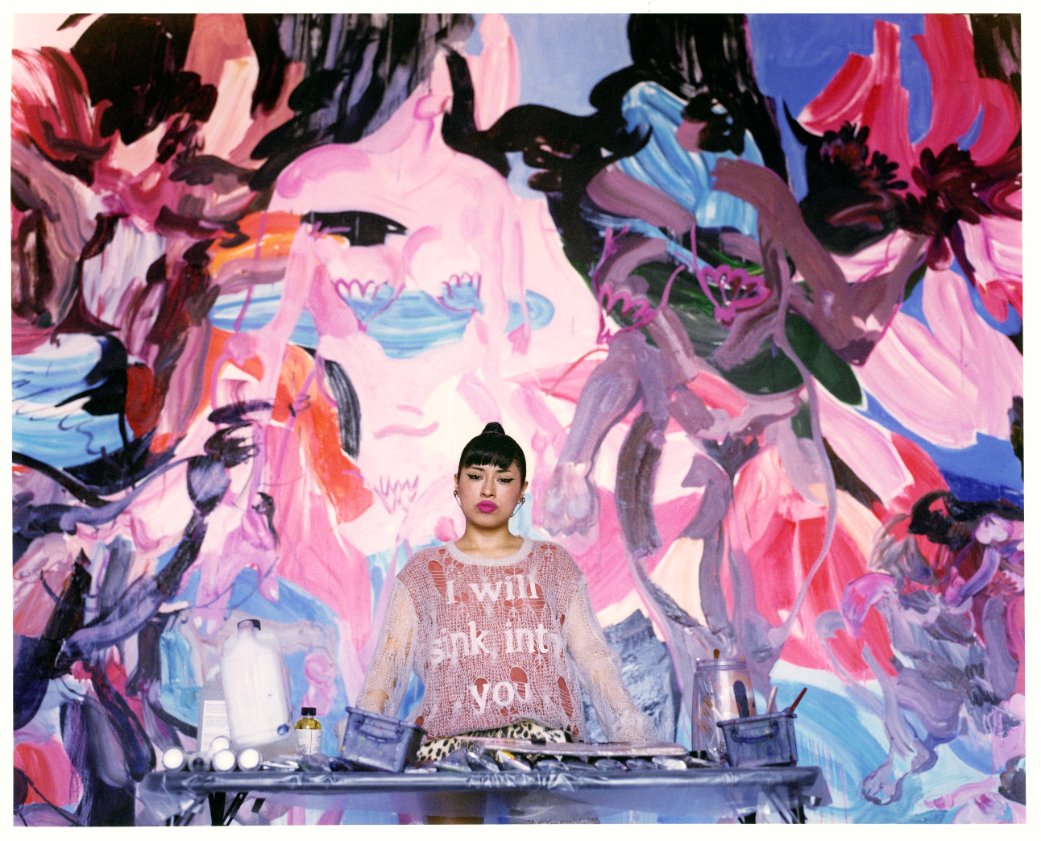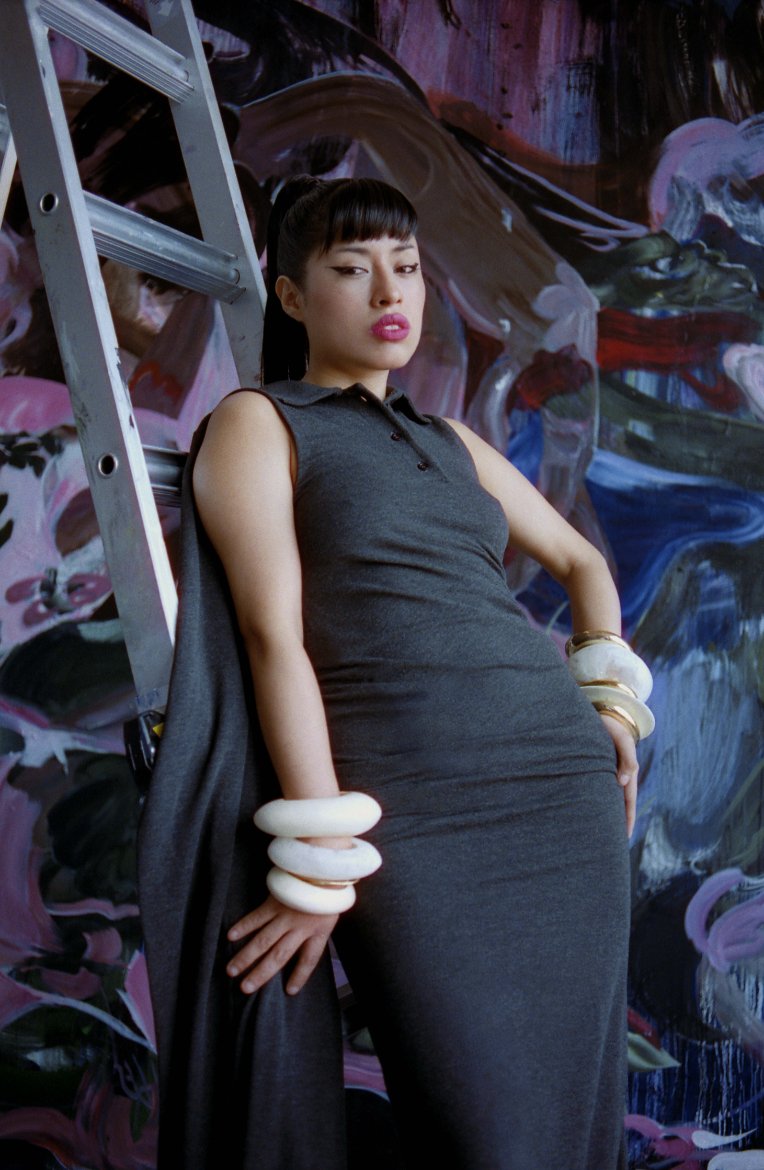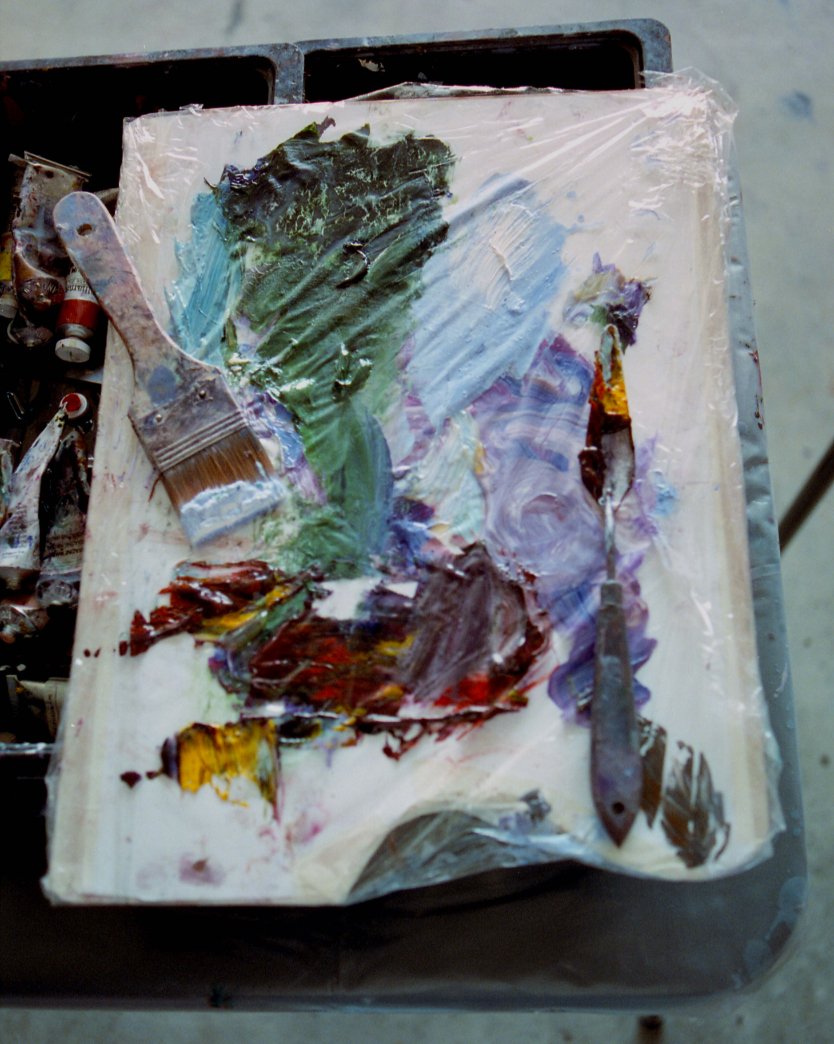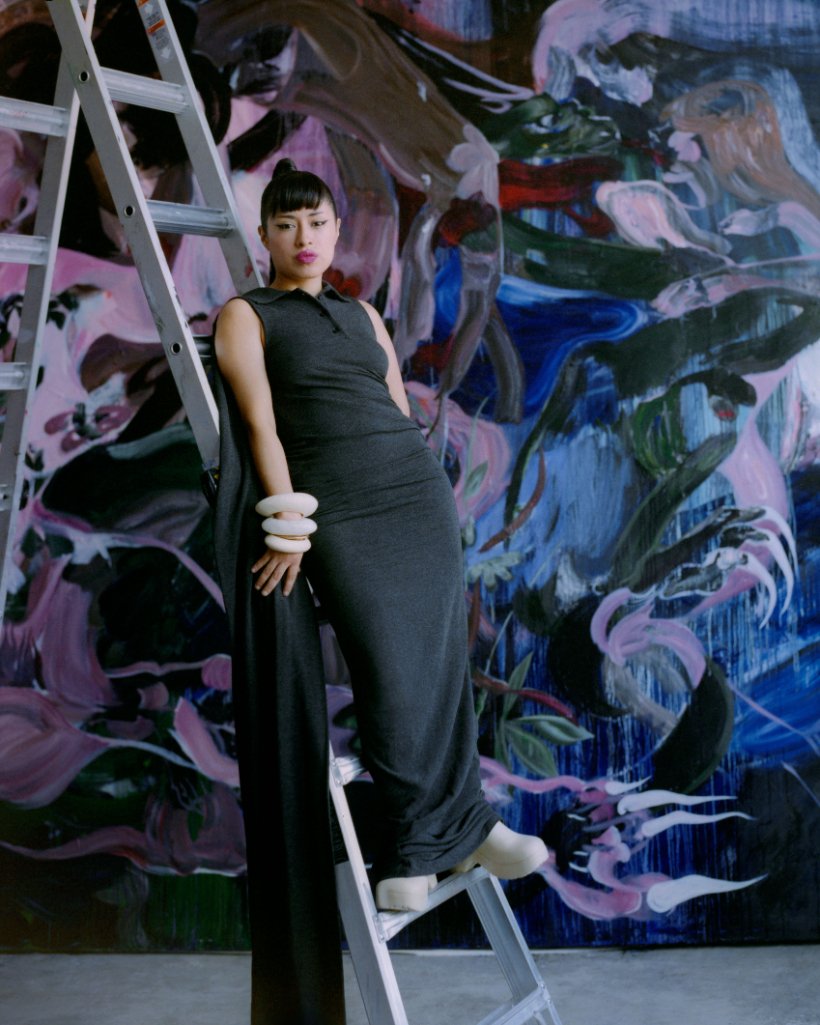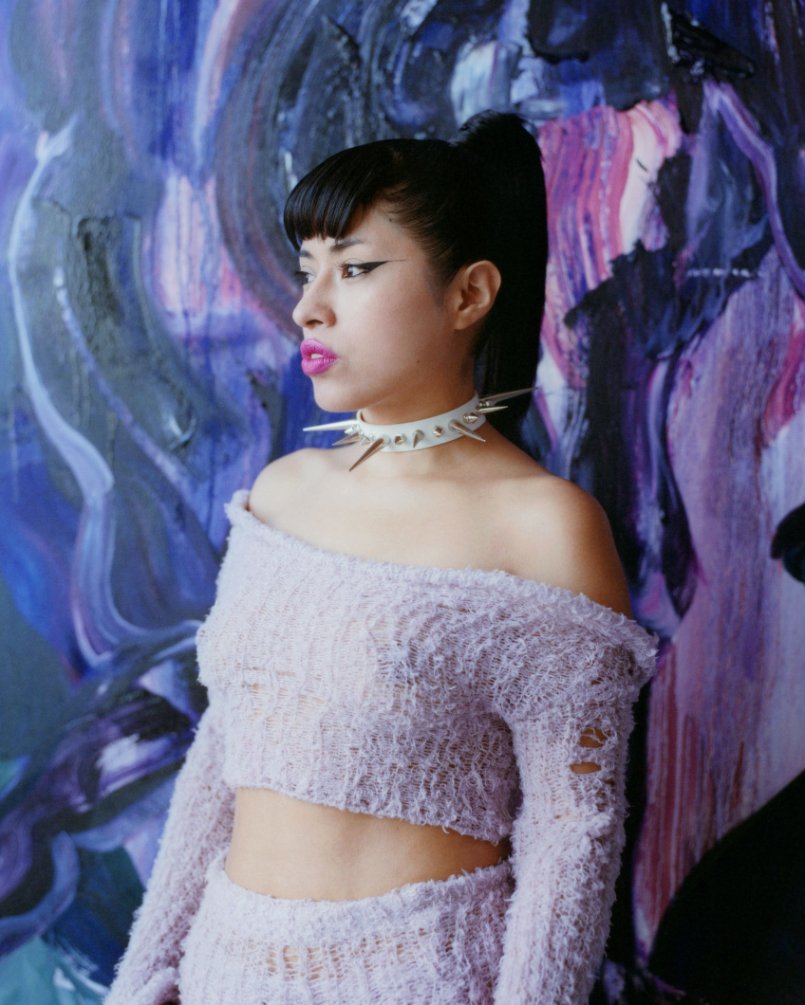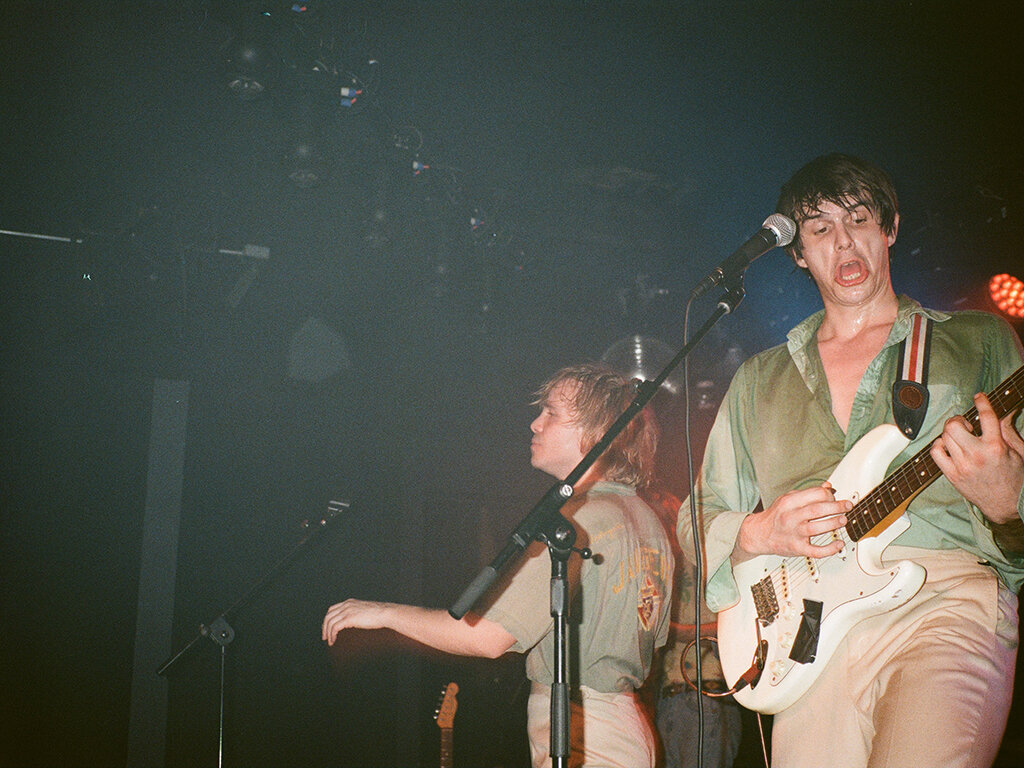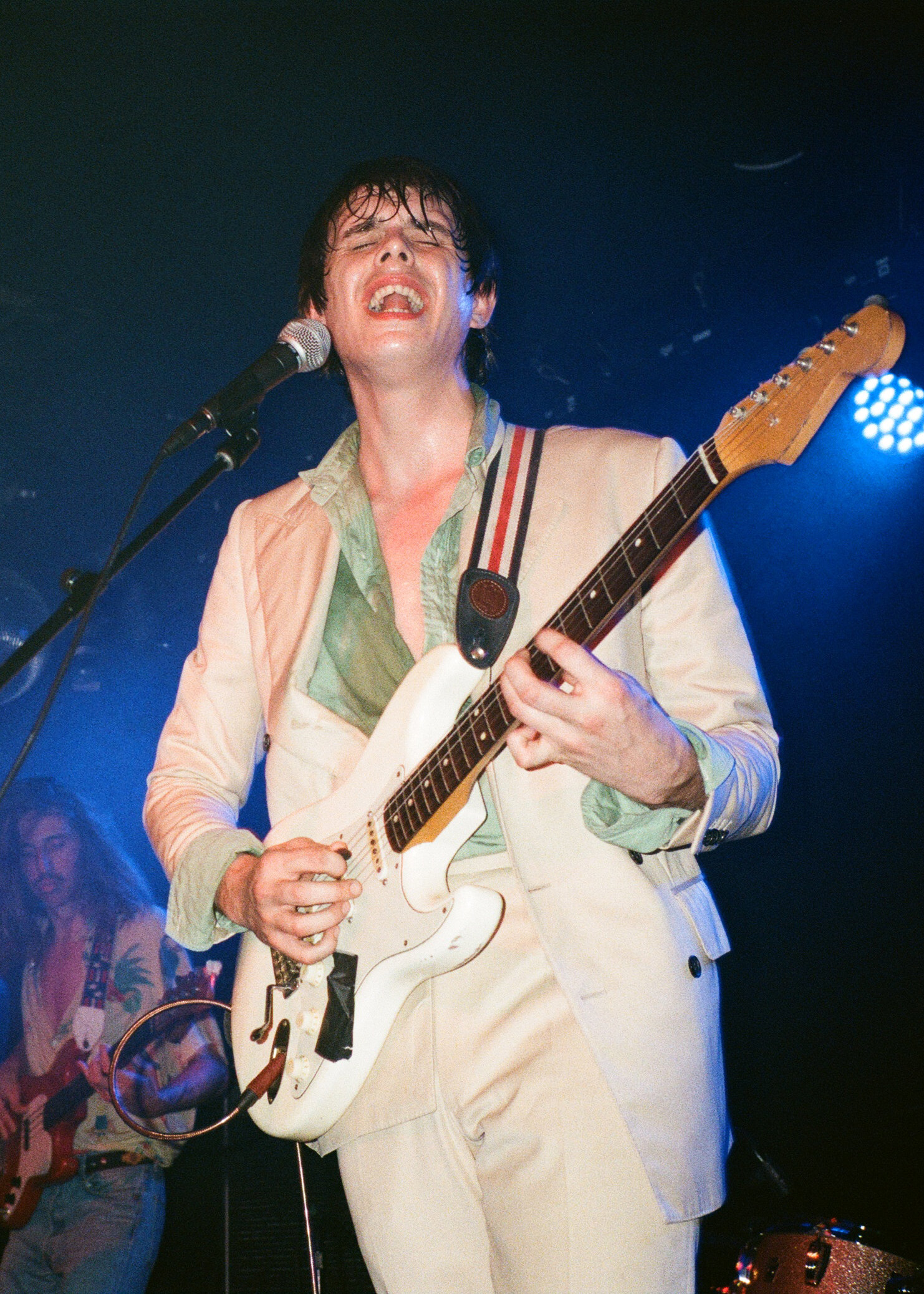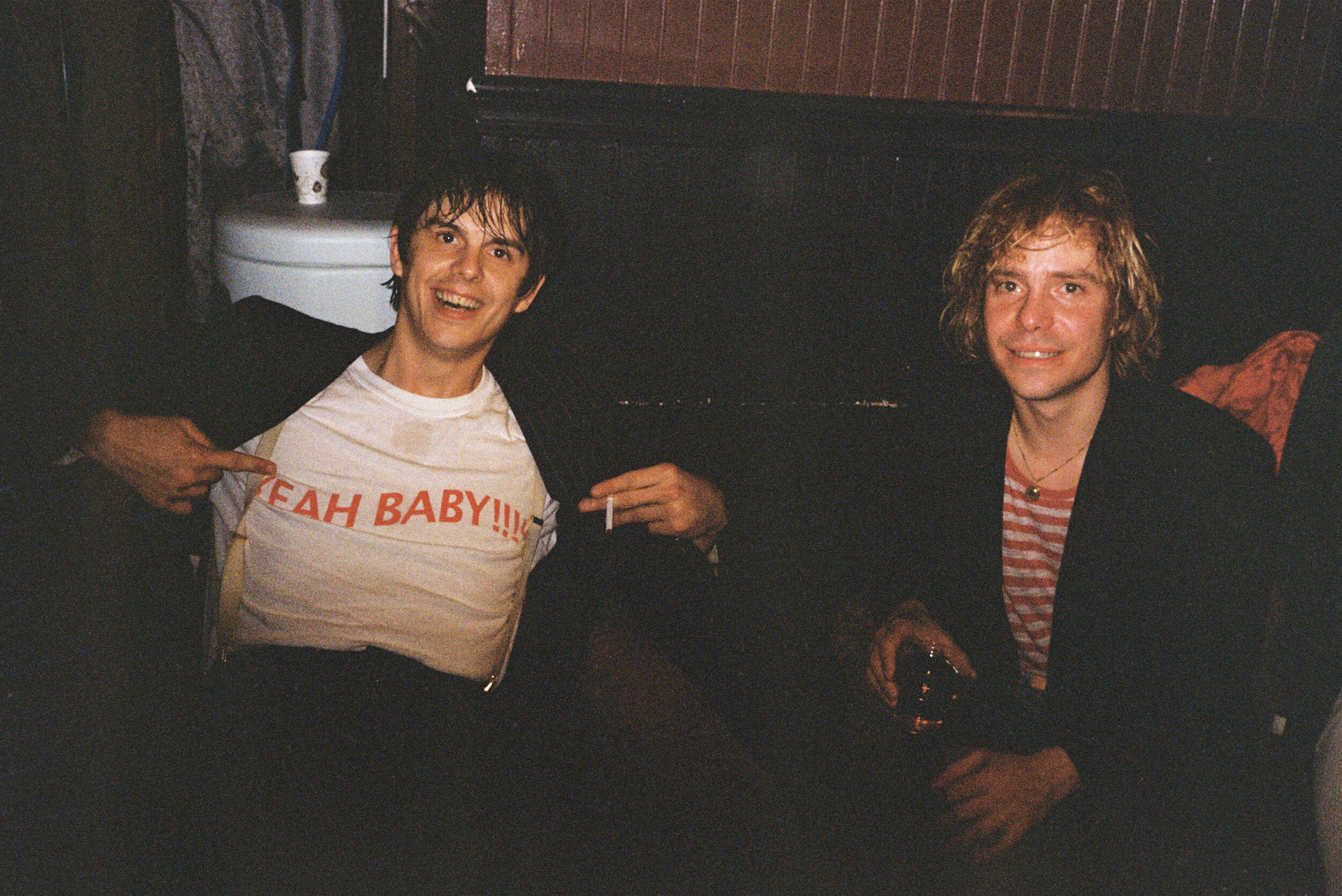top and earrings: Heaven by Marc Jacobs
interview by Jesus Nebreda Galindez
creative direction by Alec Charlip
photography by Andrés Jaña
styling by Abby Bencie
makeup by Marco Castro
hair by Luisa Popović
production by BORN Artists
The question of original sin has no relevance in Lima-based artist Wynnie Mynerva’s Book of Genesis. For their inaugural American solo exhibition curated by Bernardo Mosqueira, the artist will be presenting The Original Riot, opening tomorrow (June 29) at the New Museum with a site-specific installation that constitutes the largest painting ever to be presented by the institution, as well as a sculptural element that was surgically removed from the artist’s own body. The readaptation of both mythology and anatomy is central to Mynerva’s quintessentially plastic life and practice; one that finds itself in a constant state of radical change. Painting and performance are a fluent oscillation of being as demonstrated in their 2021 exhibition Closing to Open at Ginsberg Gallery in Madrid when the artist had their vagina sutured three quarters of the way shut, allowing only for the flow of their bodily fluids to function as necessary. The corporeal roles of masculine and feminine are constantly being subverted and abstracted in works that bleed, scratch, beguile, and thrust their way through the patriarchal canon with an air of wanton ecstasy. The binary creation myth was recently addressed in Mynerva’s first UK solo exhibition Bone of My Bones Flesh of My Flesh at Gathering London earlier this year, introducing many for the first time to the role of Lilith in Judaic and Mesopotamian folklore as Adam’s first wife who was created from the same clay (equal in nature) as her husband. Her pitiable fate varies from one myth to the next, but the creation of a second wife (Eve) from his rib remains consistent. The artist’s decision to remove Adam’s body from their own for The Original Riot demonstrates the power to readapt our personal realities at will. It is a reflection of the agency that we unwittingly deny ourselves when we allow allegory to shape our internalized perspectives. The following interview was conducted in Spanish and is presented here in its original form, followed by its English translation.
JESUS NEBREDA GALINDEZ: Quiero empezar con cómo te convertiste en artista. ¿Hubo un punto de inflexión en tu vida que te llevó a elegir este camino?
WYNNIE MYNERVA: Creo que la inclinación por hacer arte solo fluyó. Siempre he sido una persona con necesidad inventiva e inquieta. Algo que fue determinante y por la cual me acerqué al arte, fue la sensación de no sentirme dentro de mi cuerpo. Recuerdo desde niña verme como “otro ser” que me miraba desde lejos, esa sensación aún me persigue y se ha convertido en un espacio, y dentro de ese espacio estoy ejecutando diferentes simulaciones y constantemente deconstruyéndome en imágenes. Es por eso que mi trabajo toca temas íntimos pero también universales, la existencia, el disfrute, el dolor, el cuerpo, la carne, la sexualidad. El arte está plagado de pequeños milagros porque no existe una forma fija de creación, y esa idea me seduce.
GALINDEZ: Los tonos rosas, rojos, marrones y piel de melocotón dominan su trabajo anterior. ¿Puedes hablar sobre tu paleta de colores y cómo llegaste a su desarrollo?
MYNERVA: El color para un pintor es como una bocanada de aire, puede medir la temperatura que atraviesan las emociones y la atmosfera de su tiempo. Trabajo en rojos, marrones y rosas, pero también he vuelto a utilizar el negro que lo había casi había desaparecido de mi obra, siento en general una sensación de retornar a tonos más oscuros. Luego que por sorpresa dentro de la pandemia mis colores estallarán en luz por pasar tanto tiempo observando todo desde lo digital y las redes sociales.
GALINDEZ: ¿Cómo se siente estar exhibiendo su trabajo en el New Museum? ¿Crees que sigue siendo relevante el hablar de centro y periferia dentro de la escena artística? ¿O por el contrario, la era de internet ha roto para siempre estas históricas barreras geográficas?
MYNERVA: Estoy un poco nerviose. Definitivamente. Especialmente trabajando por primera vez con un museo y uno tan importante como es el New Museum en Nueva York. Siento que es una acumulación de placer y trabajo por mis convicciones lo que hizo que yo esté aquí ahora. Pienso que es relevante no solo que estoy aquí, sino con quiénes estoy, y con esto quiero responder a tu pregunta sobre centro y periferia. Es importante a quiénes he nombrado en mis proyectos y quiénes me han llevado a pensar de esta manera y no de otra. Siento que es fundamental aún hacer referencia a los sistemas sociales, políticos y económicos que nos condensan. La era del internet no ha roto estas barreras, ha generado una sensación placebo para aliviar la impresión de desigualdad en la escena artística.
GALINDEZ: Estarás montando la pintura más grande que el museo ha presentado en su historia. ¿Por qué la escala de esta pieza fue tan importante para ti?
MYNERVA: El espacio de exhibición es para mí como un escenario. Las pinturas se convierten en el paisaje, y me interesa abarcarlo todo con la escala, los espectadores dan inicio a la función con sus cuerpos. La pintura es el marco arquitectónico que ofrezco al público. Es la propia obra que induce al cuerpo a recorrerla. La escala te envuelve y está diseñada de forma específica, no es trasladable, por tanto es una experiencia singular. La pintura deja de ser un objeto coleccionable para convertirse en geografía.
GALINDEZ: Tu maravillosa exposición Bone of My Bones, Flesh of my Flesh en el Gathering de Londres abordaba no solo la historia de Adán y Eva sino que se adentraba en territorios mucho más desconocidos, hablamos del mito de Lilith. Tu nueva obra, The Original Riot—dios me encanta el título—reinterpreta y se sumerge en esta inquietante alegoría. ¿Puedes contarnos cómo fue el proceso de quitarte una costilla y por qué cobra tanta significación en esta obra?
MYNERVA: Me enteré de la oportunidad de exhibir en el New Museum en medio de la preparación de Bone of My Bones, Flesh of My Flesh en Londres, y supe que este sería el espacio para desenlace de este proyecto: la extracción de mi costilla de Adán. Ha sido un proceso largo y estoy tratando de mantener un buen equilibrio, que un proyecto no se mueva demasiado rápido o demasiado lento, pensar como en el cine, que el tiempo es un elemento, y el tiempo de recuperación de mi cuerpo también tiene belleza.
En The Original Riot hay más de una historia revuelta. Parto de la mitología del génesis de Adán y Eva, Eva creada a partir de la costilla de Adán para servirle. Antes que Eva existió otra figura femenina de nombre Lilith que desafiaría a Adán y se negaría a reproducirse, por lo cual Dios la castigaría convirtiendo su vagina en una llama azul eterna y la expulsaría del paraíso hacia el infierno. En The Original Riot que es la segunda entrega de mi versión de esta historia, las dos primeras figuras femeninas se conocen y pactan una alianza. Como prueba de esa alianza, Eva se quita la costilla de Adán y se la entrega a Lilith. Esta costilla estará presente en la exhibición a modo de reliquia, que es la presencia materializada de un hecho sagrado. La extracción de mi propia costilla y su uso para esta exhibición es brindar mi cuerpo como parte de esta revuelta. Sacar el cuerpo del otro de mi propio cuerpo.
dress: Loewe
bangles: Dinosaur Designs
GALINDEZ: Siento curiosidad por la íntima relación entre tu cuerpo y tu arte. Esta no es la primera vez que realiza modificaciones en su cuerpo como parte de su práctica. Cuando se trata de tu cuerpo y tu práctica, ¿dónde comienza uno y termina el otro?
MYNERVA: Puedo visualizarme como una persona que ha aprendido a vivir con un cuerpo herido, en una sociedad agitada. Siempre regreso desde el arte a buscar esas señales, no como turista de mis propias experiencias, ni para nombrar mis desastres personales, sino buscando herramientas que tengan la capacidad de sanar. Pienso que trabajar en el cuerpo de hoy es trabajar en el cuerpo del futuro. Y es así como veo mis proyectos, conectando a través de lo real, la materialidad y su red de significados en la historia del arte y la humanidad. El arte tiene sentido si incide en la vida y es aplicable para una transformación social. Mi vida y mi trabajo tienen una dinámica fluida.
GALINDEZ: Tu obra está cargada de corporeidad y es cierto que los rituales del cuerpo hablan de una manera intrínseca y sin engaños de nuestras herencias culturales y sistemas sociales heredados. ¿Qué es para ti la moda? ¿Crees que es una forma de disfrazarse, o quizás ser la forma más alta y representativa de representación personal?
MYNERVA: La moda es juego encantador, pero también es una cárcel. A mí me gusta la moda del desafío, aquello que es difícil de usar, el taconazo, las plataformas y hacer malabares con los pies. Hay algo masoquista en usar corset apretado y látex en verano. Verme falsa y producida. Hay que divertirse pienso o si no se convierte en un conjunto de reglas elitistas, se puede sufrir mucho en las cárceles de las marcas y el buen vestir. Como siempre, lo correcto se apodera del placer, y salen a las calles los policías de la moda. Yo en la moda no tengo más compromiso a levantar miradas, me encanta.
GALINDEZ: ¿Cómo te sientes representada por los medios? ¿Algo qué alegar que haya sido malinterpretado?
MYNERVA: Siempre soy una persona completamente diferente presentándome. Todos estamos en constante cambio, una transición hasta la hora de la muerte. Pero luego también estoy empujando de forma abstracta mi cuerpo hacia afuera y mi entorno, de forma imperfecta y defectuosa. Muchas veces se ha entendido mi obra solo como provocadora, y la verdad solo se me ocurren soluciones radicales para cambios radicales.
GALINDEZ: En ese caso, ¿dónde vamos a ver a Wynnie Mynerva en el futuro?
MYNERVA: Me encantaría lanzar una productora de porno, ¿te imaginas?
top and earrings: Heaven by Marc Jacobs
skirt and leg piece: Sarah Aphrodite
bangles: Dinosaur Designs
shoes: stylist’s own
JESUS NEBREDA GALINDEZ: I want to start with how you became an artist? Was there a tipping point in your life that led to you choosing this path?
MYNERVA: I think the urge to make art just flowed. I have always been a person with an inventive and restless need. The determining thing that drew me to art was the sensation of not feeling inside my body. I remember since I was a child seeing myself as "another being" who was looking at me from afar. That feeling still haunts me. It has become a space within which I am running different simulations and constantly deconstructing myself into images. That is why my work touches on the intimate, but also other universal themes: existence, enjoyment, pain, the body, flesh, sexuality. Art is full of small miracles because there is no fixed form of creation, and that idea seduces me.
GALINDEZ: Pinks, reds, browns, and peachy flesh tones dominate your previous work. Can you talk about your color palette and how you came about its development?
MYNERVA: Color for a painter is like a gust of air. It can measure the temperature of their emotions and the atmosphere of their time. I work in reds, browns and pinks, but I have also gone back to using the black that had almost disappeared from my work. In general, I feel a sensation of returning to darker tones. Then, by surprise, in the pandemic, my colors burst into light because I was spending so much time observing everything from digital and social networks.
GALINDEZ: How does it feel to present your work at the New Museum? Is it still relevant to talk about the art scene as having a center and a periphery, or on the contrary, has the internet finally broken the constraints of geographical significance?
MYNERVA: I'm a little nervous. Definitely. Especially working with a museum for the first time and one as important as the New Museum in New York. I feel that it is an accumulation of pleasure and work for my convictions that has brought me here now. I think it is relevant not only that I am here, but who I am here with, and with this I want to answer your question about center and periphery. It is important to those who I have named in my projects and who have led me to think this way and not another. I feel that it is still fundamental to acknowledge the social, political and economic systems that condense us. The internet age has not broken these barriers, it has generated a placebo sensation to alleviate the impression of inequality in the art scene.
dress and shoes: Loewe
bangles: Dinosaur Designs
GALINDEZ: You will be mounting the largest painting that the museum has ever presented in its history. Why was the scale of this piece so important to you?
MYNERVA: The exhibition space is like a stage for me. The paintings become the landscape, and I am interested in encompassing everything with the scale. The spectators start the performance with their bodies. Painting is the architectural framework that I offer to the public. It is the work itself that induces the body to go through it. The scale surrounds you and is specifically designed, it is not portable, therefore it is a unique experience. It ceases to be a collectible object in order to become geography.
GALINDEZ: Your wonderful exhibition Bone of My Bones, Flesh of my Flesh at Gathering in London addressed not only the story of Adam and Eve but also delved into much more unknown territory, the myth of Lilith. Your new work, The Original Riot—God, I love the title—reinterprets and plunges into this disturbing allegory. Can you tell us about the process of removing a rib and why it has such significance in this work?
MYNERVA: I heard about the opportunity to exhibit at the New Museum in the midst of preparing Bone of My Bones, Flesh of My Flesh in London, and knew that this would be the space for the dénouement of this project: the removal of my Adam's rib. It has been a long process, and I am trying to maintain a good balance so that the project does not move too quickly or too slowly, to think like in the cinema, that time is an element, and my body’s time of recovery also holds beauty.
In The Original Riot, there is more than one scrambled story. I start with the mythology from Genesis of Adam and Eve, when Eve was created from Adam's rib to serve him. Before Eve, there was another female figure named Lilith who would defy Adam and refuse to reproduce, for which God punished her by turning her vagina into an eternal blue flame and expelling her from paradise to hell. In The Original Riot, which is the second installment of my version of this story, the first two female figures meet and agree to an alliance. As proof of that alliance, Eve removes Adam's rib and gives it to Lilith. This rib will be present in the exhibition as a relic, which is the materialized presence of a sacred fact. The removal of my own rib and its use for this exhibition is to offer my body as part of this revolt. It’s a removal of the other's body from my own body.
GALINDEZ: I’m curious about the intimate relationship between your body and your art. This isn’t the first time that you’ve made modifications to your body as a part of your practice. When it comes to your body and your practice, where does one start and the other end?
MYNERVA: I can visualize myself as a person who has learned to live with a wounded body in a troubled society. I always return from art to look for those signs, not as a tourist of my own experiences, nor to name my personal disasters, but looking for tools that have the ability to heal. I think that working on the body of today is working on the body of the future. And this is how I see my projects, connecting through reality, materiality and its network of meanings in the history of art and humanity. Art makes sense if it affects life and is applicable for a social transformation. My life and my work have a fluid dynamic.
top and skirt: Acne Studios
GALINDEZ: Your work is charged with corporeality and the way that our bodily rituals relate to our respective cultural heritages and social systems. Can you talk about the role of fashion and the body? Do you think it is a form of disguise, or might it be the highest and most representative form of personal representation?
MYNERVA: Fashion is a charming game, but it is also a prison. I like fashion’s challenges, things that are difficult to wear, like heels, platforms, and juggling with your feet. There's something masochistic about wearing a tight corset and latex in the summer. To see me fake and produced. You have to have fun, or else it becomes a set of elitist rules. You can suffer a lot in the prisons of brands and good dressing. As always, the right thing takes over pleasure, and the fashion police take to the streets. In fashion, I have no commitment to draw eyes. I love it.
GALINDEZ: Would you say there are any misconceptions about you as a person or about your art that you feel the need to correct, or do you feel properly represented by the media thus far?
MYNERVA: I'm always introducing myself as a completely different person. We are all in constant change, a transition until the hour of death. But then, I am also abstractly pushing my body and my environment outward, imperfectly and defectively. My work has often been understood only as provocative, and the truth is that I can only come up with radical solutions for radical changes.
GALINDEZ: In that case, where are we going to see Wynnie Mynerva in the future?
MYNERVA: I would love to launch a porn production company. Can you imagine?
Wynnie Mynerva: The Original Riot is on view through September 17 @ New Museum 235 Bowery, New York

